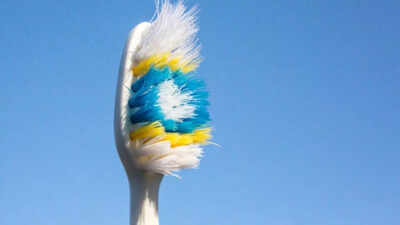ARTICLE AD BOX

Image credits: Getty Images
Even when compared to the junk food you eat, your toothbrush might be the dirtiest thing you put inside your mouth. Bacteria from the toilets to thrush-causing yeast, the thing meant to clean your teeth might be dirtied with numerous unseen deadly microbes, as per experts.According to a 2020 research published in Microorganisms, your toothbrush is home to about 1-12 million bacteria and fungi belonging to hundreds of various species. They form a biofilm on the exposed surfaces of the brush or crawl into the fractured stalks of the bristles. Then, twice daily, a dose of water, saliva, skin cells and food from our mouths gives these microbes all they need to survive and grow.
Sources of the microbes

Image credits: Getty Images
According to Marc-Kevin Zinn, a microbiologist at Rhine-Waal University of Applied Sciences in Germany, who has studied the microbial contamination of toothbrushes, the microbes on toothbrushes originate from three primary sources, he shared with BBC.
The person’s mouth, their skin and the environment the brush is kept in.When it comes to the mouth, the bristles come into contact with microbes such as Rothia denocariosa, Streptococcaceae mitis and members of the Actinomyces bacteria, all of which are normal residents. Out of these most are even good for our health, however, Streptococci and Staphylococci are two that can be harmful and lead to tooth decay. Others can cause inflammation in the gums, also known as periodontal disease.
Researchers have also found bacteria such as Escherichia coli, Pseudomonas aeruginosa, and Enterobacteria, which are associated with stomach infections and food poisoning. Pathogens such as Klebsiella pneumoniae and Candida yeasts, the former of which is a common cause of hospital-acquired infections and the latter leads to thrush.
The toilet trade

Image credits: Getty Images
Each time you press flush, tiny droplets of water and feces are thrown up to 1.5m into the air around it.
Along with these, there can be bacteria and viruses that cause flu-like Covid-19 and norovirus. Thus, if you keep your toothbrush anywhere near the toilet bowl, contents from it could settle on the bristles and go into your mouth later. Research from one university found that 60% of student toothbrushes in communal bathrooms were contaminated with bacteria found in feces, with a good chance of the microbes on one person’s brush coming from someone else’s.Some researches even show that fatal viruses such as influenza and coronavirus can survive on toothbrushes for several hours and even 48 hours in the case of herpes simplex virus-1.This is more of a concern for those whose immune systems are compromised. Research has found that at least some of the bacteria found on toothbrushes are resistant to antibiotics.
How to protect your toothbrush?

Image credits: Getty Images
The American Dental Association recommends not covering the heads of the toothbrush or storing them in closed containers as it can promote microbial growth.Additionally, leaving the toothbrush in an upright position to air dry at room temperature will kill the bacteria that die as they dry out.Soaking the head of the brush in an antiseptic mouthwash solution for 5-10 minutes can also be effective.One of the most important things to remember is changing your toothbrush every three months or so and more often for people with weak immune systems.

 2 hours ago
4
2 hours ago
4









 English (US) ·
English (US) ·